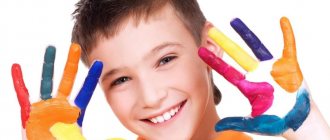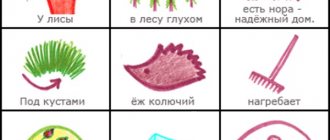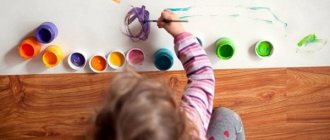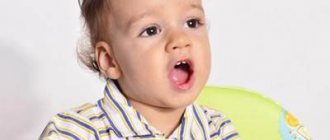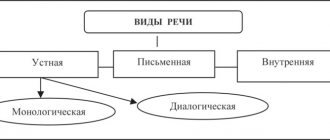Color
Recognizing color from a sample
Task : match the pictures to the color background.
Recognizing color by verbal designation
Task : the child is presented with colored figures and a verbal name for the color. The child must show the given color.
Color differentiation
Task : the child is shown several figures of different colors and given instructions to show the given color.
Naming the color
Task : the child must name the color.
Age indicators:
4 years: red, yellow, blue, green, white, black.
5 years: the same + orange, blue, pink.
6 years: the same + purple, brown, gray.
Conclusions:
— ideas about color are formed by age;
- there is no concept of color:
- does not distinguish colors;
- does not recognize and does not name colors;
— does not group shapes by color.
Diagnostics of the current level of sensory development of children of primary preschool age
The sensory development of a child is the development of his perception and the formation of ideas about the properties of objects: their color, shape, position in space, size, as well as taste, smell, etc. Sensory development at a young age is considered by many researchers to be the best for improving the functions of the senses. , accumulation of ideas about the world around him. Knowledge begins with the perception of phenomena and objects in the surrounding world. Therefore, it can be argued that sensory development is the foundation of the general intellectual development of children of primary preschool age.
The main task of sensory development of young children in preschool educational institutions is to develop the ability to perceive objects and phenomena, to highlight their inherent external properties that determine how to act with them.
Diagnosis of sensory development involves identifying the level of development of practical orientation to size, shape, color, the level of development of the holistic image of an object, orientation in space.
The basis for this diagnostic for identifying and assessing the sensory development of children of primary preschool age were the following methods: E. A. Strebeleva, L. A. Venger, M. I. Zemtsova.
During the examination, tasks are presented to the child immediately for independent completion, after the task is explained. The experimenter asks the child to group the toys; open the nesting doll and assemble it; put together a whole picture from parts, put together a flower by naming the colors and identify objects using tactile examination. Moreover, all tasks should be accompanied by natural gestures and commentary on actions.
If a child finds it difficult to complete a task on his own, the adult demonstrates the appropriate action and then asks the child to repeat it. If the preschooler cannot cope in this case, then the method of joint actions is used. For example, a teacher assembles a matryoshka doll with the hands of a child; folds a cut picture. Following this, the child is asked to act independently.
For all tasks the following is recorded:
Desire to cooperate with an adult; understanding the task; the ability to detect the error of one’s actions; interest in the final result;
Method of completing the task (failure to complete, after joint actions, after demonstration, independently);
Result: exact match to the adult model, failure, inexact match.
When starting to examine a child of primary preschool age, the experimenter needs to establish emotional contact and trusting relationships, as well as pay attention to the general condition of the child and only after that offer him to complete the following tasks:
- Grouping of toys (L. A. Wenger’s method). The task is aimed at identifying the level of development of shape perception, the ability to use geometric standards (samples) in determining the general shape of specific objects, i.e., grouping by shape.
Equipment: three boxes (without top lids, size of each wall 20 x 20 cm) of the same color with standard samples depicted on them (size 4x4 cm). On the first (on the front wall) there is a square, on the second - a triangle, on the third - a circle. A set of 24 items in a bag: 8 - similar to a square (cube, box, square button, etc.), 8 - similar to a triangle (cone, herringbone, mold, etc.), 8 - similar to a circle (coin, medal, hemisphere, etc.) (Table 4).
Set of items
| Similar to square | Similar to triangle | Similar to a circle |
| Cube | Cone | Coin |
| Boxes | Christmas tree | Medal |
| Button | Mold | Hemisphere |
| Eraser | Lid | Chick |
| Soap | Rocket | Button |
| Notebook | Prism | Ring |
| Vial (bottle) | Vial (bottle) | Ladybug |
| Battery | Pebble | Box (powder compact) |
Conducting the examination: boxes are placed on the table in front of the child. The teacher draws the child’s attention to the standard model: “Look, here is a figure like this (square), and here is this one (circle).” Then he takes an object (any) out of the bag and says: “What figure does it look like: this (showing a triangle), this (showing a circle) or this (showing a square)?” After the child points to one of the standards, the adult says: “Now throw it into this box.” Then he takes out the next object (of a different shape), and the whole procedure is repeated. Subsequently, the adult gives the child the opportunity to arrange the toys himself, asking him: “Now put all the toys in your boxes, look carefully.”
Training: if the child does not continue to complete the task independently, the adult sequentially gives the toys and asks the child to put them in the correct box. If the child lowers it, but does not focus on the model, then the adult again draws his attention to the standard model, correlating the toy with it.
Assessing the child’s actions: understanding and accepting the task; methods of implementation - the ability to work according to a model; purposefulness of actions; learning ability; attitude towards the result; result.
1 point - the child does not understand and does not accept the task; does not function adequately in learning conditions.
2 points - the child acts without being guided by a standard model; after training, continues to lower toys without taking into account the basic principle.
3 points - the child puts down toys, not always focusing on the model; after training, matches the shape of toys with the model.
4 points - the child puts down toys taking into account the pattern; interested in the end result.
- Disassemble and fold a four-part matryoshka doll (methodology by E. A. Strebeleva). The task is aimed at testing the level of development of size orientation.
Equipment: four-piece matryoshka doll.
Conducting an examination: the experimenter shows the child a matryoshka doll and asks him to see what is there, that is, to take it apart. After examining all the nesting dolls, the child is asked to collect them all into one: “Collect all the nesting dolls to make one.” In case of difficulties, training is provided.
Training: the teacher shows the child how to put together first a two-part, and then a three-part and four-part matryoshka doll, and then asks him to complete the task independently.
Assessing the child’s actions: understanding and accepting the task; methods of execution; learning ability; attitude towards the results of their activities.
1 point - the child does not accept the task, does not strive to complete it; after training does not switch to adequate methods of action.
2 points - the child understands the task, strives to act with the nesting doll, but when completing the task does not take into account the size of the parts of the nesting doll, i.e. chaotic actions are noted; acts adequately during the learning process, and after learning does not switch to an independent method of action; indifferent to the results of his activities.
3 points - the child accepts and understands the task, completes it using the method of enumerating options; After training, he switches to an independent method of completing the task; interested in the end result.
4 points - the child understands and accepts the task; folds a matryoshka doll using practical fitting and trial method; interested in the end result.
- Fold a cut picture (of three parts), (methodology by E. A. Strebeleva)
The task is aimed at identifying the level of development of the holistic perception of the subject image in the picture.
Equipment: two identical object pictures, one of which is cut into three parts (rooster or dress).
Visual material.
Conducting the examination: the experimenter shows the child three parts of a cut picture and asks: “Make a whole picture.”
Training: if the child cannot correctly connect the parts of the picture, the adult shows the whole picture and asks to make the same one from the parts. If after this the child cannot cope with the task, the experimenter himself superimposes part of the cut picture onto the whole one and asks him to superimpose another, after which he invites the child to complete the task independently.
Assessing the child’s actions: accepting the task; methods of execution; learning ability; attitude towards the result; result.
1 point - the child does not understand the task; even under training conditions it acts inadequately.
2 points - the child accepts the task, but does not understand that the parts need to be combined into a whole; puts parts one on top of another; under training conditions he often acts adequately, but after training he does not proceed to independently complete the task; indifferent to the final result.
3 points - the child accepts and understands the task; tries to connect parts into a whole picture, but cannot do it on his own; after training he copes with the task; interested in the results of his activities.
4 points - the child accepts and understands the task; independently copes with the task, using the method of targeted tests or practical trying on.
- Collect a flower (4 colors)
The task is aimed at the ability to arrange colors in accordance with the pattern and for children to name exactly these colors.
Equipment: Cards showing a stem with a core, multi-colored petals (red, blue, yellow, green).
Visual material.
Conducting an examination: give the child petals of different colors and show how to place the petals around the center of the flower in a pattern. Ask to collect all the petals, naming the colors.
Training: in cases where a child cannot fold a flower correctly, an adult shows how to do it and asks to name each petal.
Assessing the child’s actions: accepting the task; methods of execution; learning ability; attitude towards the result; result.
1 point - the child does not accept the task; acts inadequately even under training conditions.
2 points - the child accepts the task, but does not understand that the parts need to be combined into a whole; puts parts one on top of another; under training conditions he often acts adequately, but after training he does not proceed to independently complete the task; indifferent to the final result.
3 points - the child accepts and understands the task; tries to assemble a flower according to a pattern, but cannot independently name the colors of the petals; after training he copes with the task; interested in the results of his activities.
4 points - the child accepts and understands the task; independently copes with the task, names all the colors correctly.
- “What does the object feel like,” “What is it made of?” (adapted version of M. I. Zemtsova’s technique)
The task is aimed at testing the level of development of skills in tactile examination of objects.
Equipment: vegetables: potatoes, tomatoes, cucumbers; fruits: apple, pear, orange; toys: wooden nesting doll, soft bear, plastic cube, newsprint, sandpaper, etc., flannel glasses.
Conducting an examination: an adult shows the child objects laid out on the table, the child puts on flannel glasses, the adult asks to identify, name and describe the object by touch.
Training: an adult puts on flannel glasses and shows how to examine and describe an object, and asks the child to do the same. If after this the child does not continue to complete the task independently, the adult gives the objects one by one and asks the child to describe them, asking the questions “What shape?” What does the object feel like? etc.".
Assessing the child’s actions: accepting and understanding the task; methods of execution; learning ability; attitude towards the results of their activities.
1 point - the child does not understand the task and does not strive to complete it; after training does not switch to adequate methods of action.
2 points - the child accepts the task, strives to examine objects, but after training does not move on to an independent method of action; indifferent to the results of his activities.
3 points - the child accepts and understands the task, completes it using the method of enumerating options; After training, he switches to an independent method of completing the task; interested in the end result.
4 points - the child accepts and understands the task; tactilely examines objects by sampling or practical trying on; interested in the end result.
In connection with the study, the levels of sensory development of each of the children are revealed:
high level – completed tasks independently or after showing them to adults with a score of 20–15 points;
average level – number of points scored 15–10;
sufficient level – number of points 10–5;
initial level – number of points 5–0.
The pedagogical process should be based on a diagnostic basis. This diagnostic presents tasks for identifying and assessing the level of sensory development of children of primary preschool age, which most fully shows the level of development of practical orientation to shape and size; the ability to highlight color as a feature of an object; level of development of a holistic image of an object, orientation in space. Thus, the teacher can determine the level of sensory development of the child, taking into account the educational program.
This type of diagnosis assumes that a sufficient amount of diagnostic information should be obtained with minimal effort. The results of such diagnostics reflect the real picture of the child’s sensory development and, therefore, can increase the effectiveness of the educational process.
Consequently, this diagnosis of the sensory development of children of primary preschool age, when included in preschool education, will help teachers and parents of the child to correctly build pedagogical communication with him and help the preschooler to develop intellectually.
Literature:
- Wenger L.A., Pilyugina. E.G., Wenger N.B. Raising a child’s sensory culture. - M. Education, 1988, P. 144.
- Zemtsova, M. I. Ways to compensate for blindness in the process of cognitive and labor activity [Text] / M. I. Zemtsova. - M.: Iz-vo APN RSFSR, 1956. - 420 p.
- Mukhina V.S. Child psychology. - M.: LLC April Press, ZAO Publishing House EKSMO-Press, 1999. - 352 p.
- Poddyakov.N. N. Sensory education of a child in the process of constructive activity // Theory and practice of sensory education in kindergarten, - M. Education, 2001. - 456 p.
- Psychological and pedagogical diagnostics of the development of children of early and preschool age: method, manual: with appendix. Album “At a glance. material for examining children”/ [E. A. Strebeleva, G. A. Mishina, Yu. A. Razenkova and others]; edited by E. A. Strebeleva. — 2nd ed., revised. and additional - M.: Education, 2004. - 164 p.
Form
Tasks:
- show geometric figures and shapes upon request;
- group them;
- correlate figures and shapes with specific objects from the environment;
- name the figures and shapes.
Age indicators:
4 years: circle, square, triangle.
5 years: the same + rectangle, ball, cube.
6 years : the same + oval, rectangle, quadrangle..
Conclusions:
— ideas about form are formed according to age;
- has no concept of form:
- does not group geometric shapes;
- does not distinguish and name geometric shapes (flat and three-dimensional);
- does not correlate the shape of an object with a geometric shape;
- does not group objects by shape.
Montessori Sensory Development Ideas at Home
Despite the fact that Montessori centers use specialized kits for the development of children, it is not difficult to create a game that enriches a child’s sensory experience.
- Animal competitions. Discuss with your child how different animals move and try to organize a competition: draw a start and finish line and ask them to run sideways like a crab, hobble like a bear, or jump like a hare.
- Modeling. Kinetic sand, salt dough, plasticine and clay perfectly develop a child's tactile sensitivity. You don’t have to try to create a masterpiece right away: just learn how to roll balls, flatten them into pancakes, stretch them into sausages, squeeze them and watch how the material seeps through your fingers
- Draw with crayons on the pavement and play hopscotch. Like the previous exercise, this trains not only the senses, but also the child’s coordination.
- Game of silence. Is it just not interesting to remain silent anymore? Invite your child to remember 5 different sounds that he heard during a minute of silence (car horn, bird sounds, people talking, a dropped pencil, etc.)
- Treasure hunt. Draw a list of objects that your child should find during your next walk (a long rough pine cone, a red leaf, a yellow leaf, a dry branch, etc.). Don't forget to take a pen with you to cross out what you find.
- Drawing with stamps, fingers, brushes and even cotton swabs. It is difficult to overestimate the impact of free creative activities on a child’s development.
- Guess the smell. Place items with different scents in opaque boxes: your favorite shampoo, orange peel, a little vanilla, dried cloves, fried cutlet. Organize a competition for the keenest sense of smell.
- Experiment with musical instruments: xylophone, glucophone, kalimba, drum, tambourine, shaker, pipe. It is not necessary to immediately enroll in a music school to introduce your child to music.
- Guess the product by taste. Blindfold your child and ask him to guess what's for lunch today.
- Let your child walk barefoot more often, because there is a whole world under his feet: sand, lawn, stream, pebbles.
Magnitude
Tasks:
- show objects of contrasting size upon request;
- arrange objects in ascending and descending order;
- name the corresponding quantity ratios.
Age indicators:
4 years: long - short, wide - narrow, high - low.
5 years: 4 gradations of each characteristic, determined by comparison (the red stripe is shorter than the yellow one, but wider than the green one).
6 years: 5 gradations of each characteristic, determined by comparison.
Conclusions:
— ideas about size are formed according to age;
- there are no concepts of size:
- does not differentiate objects of contrasting size;
- does not arrange objects in ascending and descending order;
- does not use words in speech that characterize quantities and their relationships.
conclusions
The development of a child begins with the development of his senses. In the 21st century, this is not just the opinion of teachers, but a scientifically proven fact. At an early age, it is very important for a child to learn as much as possible about the world around him using all his senses, which is why no computer can replace a child’s real experience of being in a different environment (forest, park, store, kitchen, etc.). Try to introduce your baby to a variety of objects, and think about how to organize a sensory development area for him, if the ideas of Maria Montessori are close to you.
Time orientation
Tasks:
- show the corresponding time categories in the pictures;
- name the time categories shown in the pictures;
- select a series of pictures to the corresponding time categories and explain the selection criteria.
Age indicators:
4 years : morning, afternoon, evening, night.
5 years : morning, day, evening, night, yesterday, today, tomorrow, seasons.
6 years: morning, afternoon, evening, night, day, earlier, later, yesterday, today, tomorrow, seasons.
Conclusions:
— ideas about time are formed according to age;
— temporary representations are not formed:
— does not find it in the pictures;
- does not name;
- doesn’t explain.
Orientation in space
Tasks:
— show relevant spatial references;
- move in a given direction;
- name the corresponding spatial landmarks.
Age indicators:
4 years: show objects located above, below, in front, behind, left, right.
5 years: show objects located above, below, in front, behind, left, right, in front of me, to my right, to my left.
6 years old: show objects located above, below, in front, behind, left, right, left, between, next to, around.
Conclusions:
— spatial representations correspond to age;
- there are no concepts of space;
- does not perform a movement in the indicated direction according to verbal instructions;
- does not determine position in space in relation to itself;
- does not use words denoting the location of an object in space.

